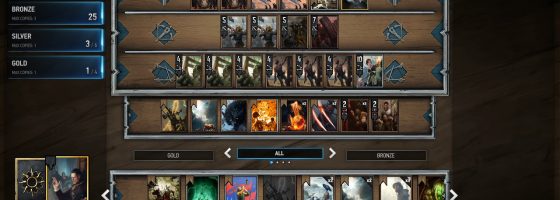Trending
Opinion: How will Project 2025 impact game developers?
The Heritage Foundation's manifesto for the possible next administration could do great harm to many, including large portions of the game development community.
Balancing in any game design can be a tough job, so I wanted to talk about the three universal variables that must be considered for any game.

Video game balance is a multi-layered topic that varies depending on the genre and design. From spells in a RPG to cards in a CCG, we could have posts dedicated to all of them. However, every game ever made in terms of balance boils down to three variables for the designer to think about.

Gwent
For this post, while we are focusing on abstracted systems, we can also talk about the abilities in skill-based titles as well.
The power simply refers simply to how much damage said ability can do. Of the three we're going to talk about today, power is the easiest to explain. If one spell does 10 damage and another does 20, then it's easy to see what's stronger. Might by itself is also the easiest to see in terms of balance; hence the need for the other two.
In action titles, power can also refer to the amount of damage a move will do. When balancing power, it's important to avoid false choices. A false choice in this case is if something is either too strong not to use, or too weak to ever use.
Talking about nothing but power is boring, so let's add another detail.
Utility is when things get interesting, and can mean different things. Typically, utility refers to any added or special benefit that doesn't involve damage. A quick list -- Healing, buffs/debuffs, trap cards, stuns, additional action and many more.
The point about utility is that it provides a counterbalance to power. Something with a lot of power will usually not have a lot of utility and vice-versa.
A great example of this would be in Gwent and CCG design. Cards that have powerful effects will usually have less strength compared to cards with higher strength, but don't do as much on the board. When talking about action games, we can also include skills that hit more enemies or have a different shot pattern.
It's important to properly balance the utility of the option with how it relates to other abilities. Some games like XCOM 1 and 2 have rule breaking abilities in the form of attacks that ignore probability. In this case, the utility is balanced by the number of times you can use them on a given mission.
The final point and what ties everything together is the cost.
The cost of using skill can be represented by different attributes. We can talk about a resource cost, cool-down, or in action games: The time it takes to use the attack. Cost is an ever present variable when it comes to balancing.
The cost to use something must be representative of its impact. If you have an attack that can kill everything in one shot, being able to use it every 5 seconds would be pretty game-breaking. Ultimately the cost of a skill or item should be proportional to where it stands on the power/utility balance.
A popular balancing suggestion is to have higher level or more powerful skills balanced to have longer cooldowns or cost compared to weaker or lower level options. The reason is that it keeps the lower skills relevant while balancing the enhanced power or utility of later skills.

XCOM 2
Cost, power and utility must always be kept in check when balancingAn important point about cost is that you can make something too costly. We talked about the example of overpowered items in JRPGs that players would hoard. If the cost is too much for the power or utility, players will not use it.
The triangle of power, utility and cost should always be factored in when balancing options in a video game. A choice should never become too good or too bad, and thinking about these three variables is an important thought process for a game designer. An easy way to create false choices is to have an imbalance in your design.
If something is always being used or being avoided, take a look and see how it compares to everything else. Depending on the design, getting things 100% balance may be impossible, but it's a task that you always have to do; especially if the game is multiplayer.
The topic of game balance is one that we can keep talking about in many disciplines. Let me know if there are other areas you want me to cover in future posts.
Read more about:
BlogsYou May Also Like